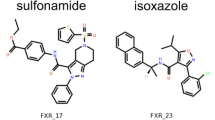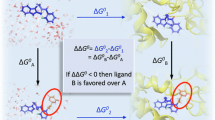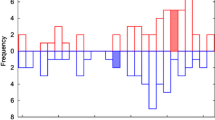Abstract
The opportunity to prospectively predict ligand bound poses and free energies of binding to the Farnesoid X Receptor in the D3R Grand Challenge 2 provided a useful exercise to evaluate CHARMM based docking (CDOCKER) and \(\lambda\)-dynamics methodologies for use in “real-world” applications in computer aided drug design. In addition to measuring their current performance, several recent methodological developments have been analyzed retrospectively to highlight best procedural practices in future applications. For pose prediction with CDOCKER, when the protein structure used for rigid receptor docking was close to the crystallographic holo structure, reliable poses were obtained. Benzimidazoles, with a known holo receptor structure, were successfully docked with an average RMSD of 0.97 \(\AA\). Other non-benzimidazole ligands displayed less accuracy largely because the receptor structures we chose for docking were too different from the experimental holo structures. However, retrospective analysis has shown that when these ligands were re-docked into their holo structures, the average RMSD dropped to 1.18 \(\AA\) for all ligands. When sulfonamides and spiros were docked with the apo structure, which agrees more with their holo structure than the structures we chose, five out of six ligands were correctly docked. These docking results emphasize the need for flexible receptor docking approaches. For \(\lambda\)-dynamics techniques, including multisite \(\lambda\)-dynamics (MS\(\lambda\)D), reasonable agreement with experiment was observed for the 33 ligands investigated; root mean square errors of 2.08 and 1.67 kcal/mol were obtained for free energy sets 1 and 2, respectively. Retrospectively, soft-core potentials, adaptive landscape flattening, and biasing potential replica exchange (BP-REX) algorithms were critical to model large substituent perturbations with sufficient precision and within restrictive timeframes, such as was required with participation in Grand Challenge 2. These developments, their associated benefits, and proposed procedures for their use in future applications are discussed.







Similar content being viewed by others
References
Abel R, Mondal S, Masse C, Greenwood J, Harriman G, Ashwell MA, Bhat S, Wester R, Frye L, Kapeller R, Friesner RA (2017) Accelerating drug discovery through tight integration of expert molecular design and predictive scoring. Curr Opin Struct Biol 43:38–44
Adcock SA, McCammon JA (2006) Molecular dynamics: survey of methods for simulating the activity of proteins. Chem Rev 106:1589–1615
Akwabi-Ameyaw A, Bass JY, Caldwell RD, Caravella JA, Chen L, Creech KL, Deaton DN, Jones SA, Kaldor I, Liu Y, Madauss KP, Marr HB, McFadyen RB, Miller AB, Navas F III, Parks DJ, Spearing PK, Todd D, Williams SP, Wisely GB (2008) Conformationally constrained farnesoid X receptor (FXR) agonists: naphthoic acid-based analogs of GW 4064. Bioorg Med Chem Lett 18:4339–4343
Armacost KA, Goh GB, Brooks CL III (2015) Biasing potential replica exchange multisite \(\lambda\)-dynamics for efficient free energy calculations. J Chem Theory Comput 11:1267–1277
Baig MH, Ahmad K, Roy S, Ashraf JM, Adil M, Siddiqui MH, Khan S, Kamal MA, Provazník I, Choi I (2016) Computer aided drug design: success and limitations. Curr Pharm Design 22:572–581
Ban F, Dalal K, Li H, LeBlanc E, Rennie PS, Cherkasov A (2017) Best practices of computer-aided drug discovery: lessons learned from the development of a preclinical candidate for prostate cancer with a new mechanism of action. J Chem Inform Model 57:1018–1028
Best RB, Mittal J, Feig M, MacKerell AD Jr (2012) Inclusion of many-body effects in the additive CHARMM protein CMAP potential results in enhanced cooperativity of \(\alpha\)-helix and \(\beta\)-hairpin formation. Biophys J 103:1045–1051
Best RB, Zhu X, Shim J, Lopes PEM, Mittal J, Feig M, MacKerell AD Jr (2012) Optimization of the additive charmm all-atom protein force field targeting improved sampling of the backbone \(\phi\), \(\psi\) and side-chain \(\chi _1\) and \(\chi _2\) dihedral angles. J Chem Theory Comput 8:3257–3273
Brooks BR, Brooks CL III, Mackerell AD Jr, Nilsson L, Petrella RJ, Roux B, Won Y, Archontis G, Bartels C, Boresch S, Caflisch A, Caves L, Cui Q, Dinner AR, Feig M, Fischer S, Gao J, Hodoscek M, Im W, Kuczera K, Lazaridis T, Ma J, Ovchinnikov V, Paci E, Pastor RW, Post CB, Pu JZ, Schaefer M, Tidor B, Venable RM, Woodcock HL, Wu X, Yang W, York DM, Karplus M (2009) CHARMM: the biomolecular simulation program. J Comput Chem 30:1545–1614
Brooks BR, Bruccoleri RE, Olafson BD, States DJ, Swaminathan S, Karplus M (1983) Charmm: a program for macromolecular energy, minimization, and dynamics calculations. J Comput Chem 4:187–217
Carlson HA, Smith RD, Damm-Ganamet KL, Stuckey JA, Ahmed A, Convery MA, Somers DO, Kranz M, Elkins PA, Cui G, Peishoff CE, Lambert MH, Dunbar JB Jr (2016) CSAR 2014: a benchmark exercise using unpublished data from pharma. J Chem Inform Model 56:1063–1077
Chen VB, Arendall WB, Headd JJ, Keedy DA, Immormino RM, Kapral GJ, Murray LW, Richardson JS, Richardson DC (2010) Molprobity: all-atom structure validation for macromolecular crystallography. Acta Crystallogr D 66(1):12–21
Chodera JD, Mobley DL, Shirts MR, Dixon RW, Branson K, Pande VS (2011) Alchemical free energy methods for drug discovery: progress and challenges. Curr Opin Struct Biol 21:150–160
Darden T, York D, Pedersen L (1993) Particle mesh Ewald: an N\(\cdot\)log(N) method for Ewald sums in large systems. J Chem Phys 98:10089–10092
Ding X, Vilseck JZ, Hayes RL, Brooks CL (2017) Gibbs sampler based \(\lambda\)-dynamics and rao-blackwell estimator for alchemical free energy calculation. J Chem Theory Comput 13:2501–2510
Essmann U, Perera L, Berkowitz ML, Darden T, Lee H, Pedersen LG (1995) A smooth particle mesh ewald method. J Chem Phys 103:8577–8593
Feng S, Yang M, Zhang Z, Wang Z, Hong D, Richter H, Benson GM, Bleicher K, Grether U, Martin RE, Plancher JM, Kuhn B, Rudolph MG, Chen L (2009) Identification of an N-oxide pyridine GW4064 analog as a potent FXR agonist. Bioorg Med Chem Lett 19:2595–2598
Gagnon JK, Law SM, Brooks CL (2016) Flexible cdocker: development and application of a pseudo-explicit structure-based docking method within charmm. J Comput Chem 37:753–762
Gathiaka S, Liu S, Chiu M, Yang H, Stuckey JA, Kang YN, Delproposto J, Kubish G, Dunbar JB Jr, Carlson HA, Burley SK, Walters WP, Amaro RE, Feher VA, Gilson MK (2016) D3R grand challenge 2015: evaluation of protein-ligand pose and affinity predictions. J Comput Aided Mol Design 30:651–668
Frisch MJ, Trucks GW, Schlegel HB, Scuseria GE, Robb MA, Cheeseman JR, Scalmani G, Barone V, Mennucci B, Petersson GA, Nakatsuji H, Caricato M, Li X, Hratchian HP, Izmaylov AF, Bloino J, Zheng G, Sonnenberg JL, Hada M, Ehara M, Toyota K, Fukuda R, Hasegawa J, Ishida M, Nakajima T, Honda Y, Kitao O, Nakai H, Vreven T, Montgomery JA Jr, Peralta JE, Ogliaro F, Bearpark M, Heyd JJ, Brothers E, Kudin KN, Staroverov VN, Kobayashi R, Normand J, Raghavachari K, Rendell A, Burant JC, Iyengar SS, Tomasi J, Cossi M, Rega N, Millam JM, Klene M, Knox JE, Cross JB, Bakken V, Adamo C, Jaramillo J, Gomperts R, Stratmann RE, Yazyev O, Austin AJ, Cammi R, Pomelli C, Ochterski JW, Martin RL, Morokuma K, Zakrzewski VG, Voth GA, Salvador P, Dannenberg JJ, Dapprich S, Daniels AD, Farkas O, Foresman JB, Ortiz JV, Cioslowski J, Fox DJ (2009) Gaussian 09, revision A.02. Gaussian, Inc., Wallingford
Hansen N, van Gunsteren WF (2014) Practical aspects of free-energy calculations: a review. J Chem Theory Comput 10:2632–2647
Hayes RL, Armacost KA, Vilseck JZ, Brooks CL III (2017) Adaptive landscape flattening accelerates sampling of alchemical space in multisite \(\lambda\) dynamics. J Phys Chem B 121:3626–3635
Huang Y, Chen W, Wallace JA, Shen J (2016) All-atom continuous constant pH molecular dynamics with particle mesh Ewald and titratable water. J Chem Theory Comput 12:5411–5421
Hummer G, Pratt LR, García AE (1996) Free energy of ionic hydration. J Phys Chem 100:1206–1215
Hynninen AP, Crowley MF (2014) New faster CHARMM molecular dynamics engine. J Comput Chem 35:406–413
Jorgensen WL (2009) Efficient drug lead discovery and optimization. Acc Chem Res 42:724–733
Jorgensen WL (2016) Computer-aided discovery of anti-HIV agents. Bioorg Med Chem 24:4768–4778
Jorgensen WL, Chandrasekhar J, Madura JD, Impey RW, Klein ML (1983) Comparison of simple potential functions for simulating liquid water. J Chem Phys 79:926–935
Kitchen DB, Decornez H, Furr JR, Bajorath J (2004) Docking and scoring in virtual screening for drug discovery: methods and applications. Nat Rev Drug Discov 3:935–949
Klebe G (2006) Virtual ligand screening: strategies, perspectives and limitations. Drug Discov Today 11:580–594
Knight JL, Brooks CL III (2011) Applying efficient implicit nongeometric constraints in alchemical free energy simulations. J Comput Chem 32:3423–3432
Knight JL, Brooks CL III (2011) Multisite \(\lambda\) dynamics for simulated structure-activity relationship studies. J Chem Theory Comput 7:2728–2739
Kong X, Brooks CL III (1996) \(\lambda\)-dynamics: a new approach to free energy calculations. J Chem Phys 105:2414–2423
Lavecchia A, Di Giovanni C (2013) Virtual screening strategies in drug discovery: a critical review. Curr Med Chem 20:2839–2860
MarvinSketch 16.6.6.0, ChemAxon (2016). URL www.chemaxon.com
Richter HG, Benson G, Bleicher K, Blum D, Chaput E, Clemann N, Feng S, Gardes C, Grether U, Hartman P, Kuhn B, Martin R, Plancher JM, Rudolph M, Schuler F, Taylor S (2011) Optimization of a novel class of benzimidazole-based farnesoid X receptor (FXR) agonists to improve physicochemical and ADME properties. Bioorg Med Chem Lett 21:1134–1140
Richter HG, Benson GM, Blum D, Chaput E, Feng S, Gardes C, Grether U, Hartman P, Kuhn B, Martin RE, Plancher JM, Rudolph MG, Schuler F, Taylor S, Bleicher KH (2011) Discovery of novel and orally active FXR agonists for the potential treatment of dyslipidemia and diabetes. Bioorg Med Chem Lett 21:191–194
Skjærven L, Jariwala S, Yao XQ, Grant BJ (2016) Online interactive analysis of protein structure ensembles with bio3d-web. Bioinformatics 32:3510–3512
Stewart JJP (2007) Optimization of parameters for semiempirical methods V: modification of NDDO approximations and application to 70 elements. J Mol Model 13:1173–1213
Straatsma TP, Berendsen HJC (1988) Free energy of ionic hydration: analysis of a thermodynamic integration technique to evaluate free energy differences by molecular dynamics simulations. J Chem Phys 89:5876–5886
Trott O, Olson AJ (2010) Autodock vina: improving the speed and accuracy of docking with a new scoring function, efficient optimization, and multithreading. J Comput Chem 31:455–461
van Gunsteren WF, Berendsen HJC (1977) Algorithms for macromolecular dynamics and constraint dynamics. Mol Phys 34:1311–1327
Vanommeslaeghe K, Hatcher E, Acharya C, Kundu S, Zhong S, Shim J, Darian E, Guvench O, Lopes P, Vorobyov I, Mackerell AD Jr (2010) CHARMM general force field: a force field for drug-like molecules compatible with the CHARMM all-atom additive biological force fields. J Comput Chem 31:671–690
Vanommeslaeghe K, MacKerell AD Jr (2012) Automation of the CHARMM general force field (CGenFF) I: bond perception and atom typing. J Chem Inform Model 52:3144–3154
Vanommeslaeghe K, Raman EP, MacKerell AD Jr (2012) Automation of the CHARMM general force field (CGenFF) II: assignment of bonded parameters and partial atomic charges. J Chem Inform Model 52:3155–3168
Wallace JA, Shen JK (2012) Charge-leveling and proper treatment of long-range electrostatics in all-atom molecular dynamics at constant pH. J Chem Phys 137:185105
Wang L, Wu Y, Deng Y, Kim B, Pierce L, Krilov G, Lupyan D, Robinson S, Dahlgren MK, Greenwood J, Romero DL, Masse C, Knight JL, Steinbrecher T, Beuming T, Damm W, Harder E, Sherman W, Brewer M, Wester R, Murcko M, Frye L, Farid R, Lin T, Mobley DL, Jorgensen WL, Berne BJ, Friesner RA, Abel R (2015) Accurate and reliable prediction of relative ligand binding potency in prospective drug discovery by way of a modern free-energy calculation protocol and force field. J Am Chem Soc 137:2695–2703
Word JM, Lovell SC, Richardson JS, Richardson DC (1999) Asparagine and glutamine: using hydrogen atom contacts in the choice of side-chain amide orientation. J Mol Biol 285(4):1735–1747
Wu G, Robertson DH, Brooks CL, Vieth M (2003) Detailed analysis of grid-based molecular docking: a case study of cdocker a charmm-based md docking algorithm. J Comput Chem 24:1549–1562
Yesselman JD, Price DJ, Knight JL, Brooks CL III (2011) Match: an atom-typing toolset for molecular mechanics force fields. J Comput Chem 33:189–202
Yin J, Henriksen NM, Slochower DR, Shirts MR, Chiu MW, Mobley DL, Gilson MK (2017) Overview of the SAMPL5 host-guest challenge: are we doing better. J Comput Aided Mol Design 31:1–19
Zwanzig RW (1954) High-temperature equation of state by a perturbation method. i. nonpolar gases. J Chem Phys 22:1420–1426
Acknowledgements
We thank Michael Crowley for sharing a new implementation of replica-exchange in CHARMM upon which we based BP-REX with domdec.
Funding
This work is supported by Grants from the NIH (GM037554 and GM107233).
Author information
Authors and Affiliations
Corresponding author
Rights and permissions
About this article
Cite this article
Ding, X., Hayes, R.L., Vilseck, J.Z. et al. CDOCKER and \(\lambda\)-dynamics for prospective prediction in D3R Grand Challenge 2. J Comput Aided Mol Des 32, 89–102 (2018). https://doi.org/10.1007/s10822-017-0050-5
Received:
Accepted:
Published:
Issue Date:
DOI: https://doi.org/10.1007/s10822-017-0050-5




